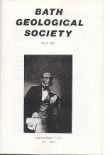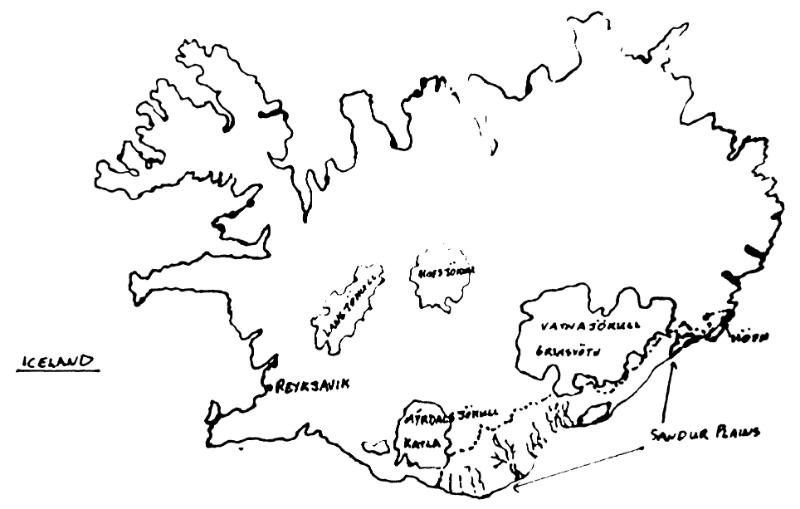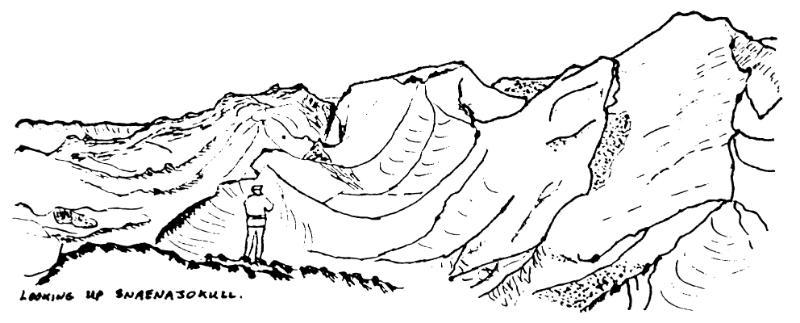Iceland

In July 1986 several of the members of this Geological Society joined a party from Bristol University in a trip around Iceland.
During periods of glaciation in the past Iceland has been completely covered by ice, except for a few of the highest mountain peaks. Still today Iceland has several permanent icefields, the largest of which is Vatnajökull with an average thickness of ice of around 420 metres. The majority of this icefield is situated on a plateau 700-800 metres above sea-level, and it descends to 150 metres along its southern margin, coming down into numerous glaciers before it melts. When moving at its maximum velocity, the ice descending towards the edge can reach 1 metre per day.

All along the southern margin of Vatnajökull are the Sandur plains, covering an area of approximately 1500 square kilometres, a vast erosional area produced by the glacial outwash. The meltwater from the glaciers is heavily charged with sand and gravel which it drops as it spreads out over the plains in ever changing braided channels. The sands are formed from basalts ground down by the glaciers and so are black, and the regularly shifting positions of the water channels prevents the development of any vegetation and so the whole plain looks dark, bare and desolate. But Iceland is a land of recent geological origin with many active volcanoes, and beneath the icecaps huge lakes occur, created by the hot volcanic activity. At intervals the water bursts out and discharges in a torrent, called in Icelandic a jökulhlaup, across the Sandur plains, often extending the shoreline out a few metres seawards with the washed down debris. At the coast, the outwash material is drawn out by the northeasterly long-shore drift into bars across the river mouths.
We travelled all around the southern margin of Vatnajökull across the Sandur plains. The first real view we had of Vatnajökull was when we stayed overnight at Nesjaskoli, 7 kilometres from Höfn. From outside our hotel we could see five glaciers coming down from the icesheet, standing out white on the skyline. We travelled along the coast to have a close look at the melting snout of Hoffellsjökull. It had a large terminal moraine about 15 metres high, trapping a small lake in front of the glacier. The melting end of the glacier was black with basalt sand. The glacier had been gradually retreating over the last one hundred years. The moraine we were looking at it from was composed of very mixed rock debris, palagonite tuff blocks and mixed diorite boulders with banding and patches of crystal aggregates in them.
We drove on to Breiðamerkur glacier, which had a sizeable lake in front of it, full of floating iceblocks that had broken from the front of the glacier. The iceblocks, some protruding 6 metres above the water, were varied in colour from pure white through greeny blue to black striped with basalt sand, and they appeared very still in the muddy water.
We actually climbed on to the end of the next glacier we visited, Snaefajökull. The very end was heaped with rock debris, but further up the debris is only formed a thin skin, and the ice showed through blue green in the deep holes and fissures caused by its break up as it met the sea.

The single biggest glacier we saw was Skeiðarárjökull in Skaftafell National Park, covering about 1600 square kilometres. It is through Skeiðarárjökull and its associated rivers that Grímsvötn, a geothermal area, creates great jökulhlaups about every five years, discharging up to 7400 cubic metres of water per second. These floods often smell strongly of sulphur compounds and occasionally bird deaths occur due to the discharged gases. The outwash plain from Skeiðarárjökull to the sea is at present 25 kilometres.
We travelled the length of the Sandur plains and went on to see the glacier Eyjafjalla, coming down from Mýrdalsjökull, which covers Katla, a fissure which erupts explosively but produces little lava, causing jökulhlaups at intervals.
The southern coastal region of Iceland provided an impressive view of the glaciers descending from Vatnajökull, all terminating on the desolate looking Sandur plains, and I don’t think any of us would have wanted to miss the experience of seeing it.
